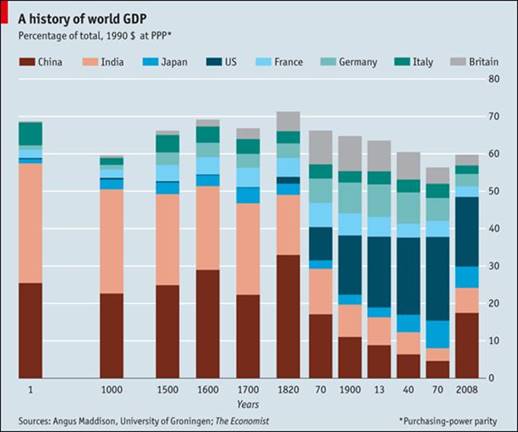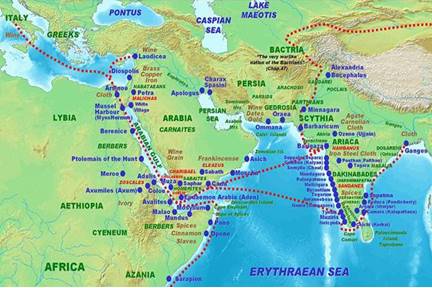By Kollengode S Venkataraman      e-mail:  thepatrika@aol.com
People talk on globalization today as if it is something new. But this has been going on for over at least 2,500 years. Before the Industrial Revolution (1760 to 1840 Common Era) triggered by the steam engine and spinning jenny in Europe, over 50% of the world GDP of those times was split between India and China for over 2,000 years. See the bar chart below (Source: The Economist). With so much of the world’s goods produced in these two Asian geographic regions, the bulk of the global trade of those times was between these two regions and Southern European  empires and the region between them—mainly Arabia, Persia, the Persian Gulf, and Central Asia. Northern and Western Europeans — today’s Advanced Societies — were living either on trees or under tree shades, or in caves. Many trade routes at the dawn of the Common Era are available on the Web. A typical one is shown further below.
empires and the region between them—mainly Arabia, Persia, the Persian Gulf, and Central Asia. Northern and Western Europeans — today’s Advanced Societies — were living either on trees or under tree shades, or in caves. Many trade routes at the dawn of the Common Era are available on the Web. A typical one is shown further below.
Global trade before the Industrial Revolution was peaceful, relatively speaking in any case, excepting for infrequent highway robberies and piracies along the routes affecting only the traders.
 However, global trade after the Industrial Revolution impacted the world in ways unimaginable before, leading to the complete destruction of native industries. The classic example is what Britain’s East India Company in India did to its sophisticated textile industries. Using foul means, the Company destroyed the sophisticated, traditional Indian textile industries in which thousands of families had been engaged for generations. Then it made the native population depend on textiles imported from England. The gory details are well documented.
However, global trade after the Industrial Revolution impacted the world in ways unimaginable before, leading to the complete destruction of native industries. The classic example is what Britain’s East India Company in India did to its sophisticated textile industries. Using foul means, the Company destroyed the sophisticated, traditional Indian textile industries in which thousands of families had been engaged for generations. Then it made the native population depend on textiles imported from England. The gory details are well documented.
Nobody knows who coined the word “globalization.†The Oxford Dictionary says the word “globalization†was first employed in 1930. What one means by “globalization†depends on who defines it:
Merriam Webster: the process of globalizing; the state of being globalized; … the development of an … integrated global economy marked… by free trade, free flow of capital, and the tapping of cheaper foreign labor markets.
Business Dictionary: The worldwide movement toward economic, financial, trade, and communications integration.
SUNY Levin Institute: Globalization is a process of interaction and integration among the people, companies, and governments of different nations. It is driven by international trade and investment, aided by information technology. This process affects the environment, culture, political systems, economic development, prosperity; and Mankind’s well-being… around the world.
Here are India’s ideas of a global village: Puranaanooru, an ancient Tamil literary work dated around 1st century of the Common Era, declares: “yaadum ooray, yaavarum keLir,â€Â literally, “Every village is my native hamlet, and all are my kinsmen.†An Upanishadic phrase echoes similarly: vasudhaiva kutumbakam, or “The whole world is, indeed, a family.â€
The industrial powers of the world, mostly European, for nearly 250 years after the Industrial Revolution, mastered mass manufacturing and international trade backed by Science and Technology (S&T). Concurrent developments in S&T helped these great powers to strengthen their armies, navies and later, air forces. With governments, industry, S&T, military, and trade mutually helping each other, European empires, controlled the world economically, politically, and militarily. Japan was the only Asian power in this context. India, in its early days after independence, was in the Soviet Camp for decades.
Decades before economists talked about integration of the world through trade, attempts were made to unite workers globally. In the 1960s, the common sloganeering among Indian Communists in rallies was, “Workers of the World, UNITE!â€Â Indian Communists, inspired by their patron saints, the Soviet Union and China, were fighting for Indians to have working conditions similar to those in Europe. But the Indian communists then were wary of internationalizing capital, production and trade; for all their “modern” outlook,  Indian communists were regressive and opposed modernization/computerization/automation. That is another story.
Soviet Union is now dead and China is only nominally Communist. But Indian Communists, like rare marooned species in far away islands from their native habitat, still survive as endangered species living in their ideological past, which China and Russia, their spiritual masters,  have abandoned decades ago. Now in India, an amalgam of Leftist Movements (communists, socialists and their fellow-travelers ensconced within the confines of the security the Indian Academia provides), is struggling to be socially and politically relevant. Discernible cracks are emerging within this amalgam.
Capitalists are no better:Â While capitalists and governments professing Free Market economy want free flow of capital and goods across borders, they do not want a free flow of workers across borders.
Also, globalization has been going on for long even in recent times, even though the term globalization was not attached to it.
- The US steel Industry was built on the backbreaking work of European immigrants, Mexicans and the nominally liberated Blacks. With a shortage of native workers, Germany’s economic miracle in the mid-20th century was possible only with Turkish “guest workers.â€
- Indian IT professionals flooding the US during the Y2K crisis at the turn of the millennium is well known. It changed the demographics of the US –Â and Indians’ self confidence in themselves –Â in a fundamental way.
- The healthcare industry in the US and the UK is sustained only with the large number of healthcare workers—mostly doctors and nurses — from the Indian subcontinent, the Philippines, and Africa.
- Your fruits/vegetables are inexpensive because migrant farm workers from Mexico and Central America toil in harsh conditions that Americans do not want to work under. Also, for a long time, produce items from Mexico and Central America have been staple in American supermarkets. Western Europe’s farming is sustained only by cheap labor from Poland, Rumania, and other Eastern European countries.
- In culturally diverse countries, such as India and China, rapid and mass migrations within the individual nation-states is a new phenomenon. It has now become more rapid, and not confined to the better educated and trading classes. In India, the less-educated muscular youth seeking livelihood are moving from poorly managed states to more prosperous regions. This has added a new dimension to India’s social complexity. .
- The luster of the United Arab Emirates, Saudi Arabia, and others is built with their petro-dollars. But they had to import technology from the West; and cheap skilled workers from the Indian subcontinent working under precarious conditions that Arab natives refused to work under.
The European trading companies, with help from their empires back home in France, England, Portugal, and Holland, ended up as colonizing/occupying powers, with Christian missionaries contributing to stir the pot. Read on the Goan Inquisition in India to know all the ghastly things unleashed by the missionaries in the Konkan region under the leadership of Francis Xavier (1502-1556), with help from Portugal’s king. Later, the Vatican canonized Xavier as a saint in 1622.
In the early days of the British East India Company (in the 18th century), Anglo-French wars were fought on Indian soil. With no stakes in the war between England and France in Europe, Indian soldiers in the armies of Robert Clive and Joseph Dupleix spilled their blood and died in the Anglo-French wars fought on Indian soil. Read on the Carnatic Wars in India (between 1744-1763) for details.
In the early 19th century, the British Empire had a huge trade deficit with China (China was a net exporter even then). To break this, England stealthily expanded its trade in China by exporting to China the opium made in India. This led to the Opium Wars (1839-60) that destroyed China’s ruling Qing dynasty, and made the Chinese populace opium addicts. The Chinese never forgot what the Europeans did to them.
The world has changed. The unbridled advantages the industrialized West had for over 250 years with their superior grasp of S&T, industrial power, military strength, and wealth have run its course. S&T is now accessible to any society willing to invest in them and work at it. China has already emerged as a global economic power, in manufacturing, trade, and military. China has captured their glorious past with a vengeance.
India is still emerging, but it may take another 30 years to regain its foothold. For this to happen the Indian middle class and its upper crust need to liberate themselves to look at India through their own lenses and not through the Europeans’ lenses. This is more easily said than done because the Indian upper crust today is completely uprooted from India’s languages and its literary, artistic and philosophical traditions. Even after seventy years since the British left India, Indian intellectuals and its middle class are in mental imprisonment of European reference points on India, craving for European recognition and acceptance in all walks of life.
In any case, Globalization, in its today’s avatar, can stave off another large-scale regional war better than even military alliances. More on this in the next issue.   ♣
